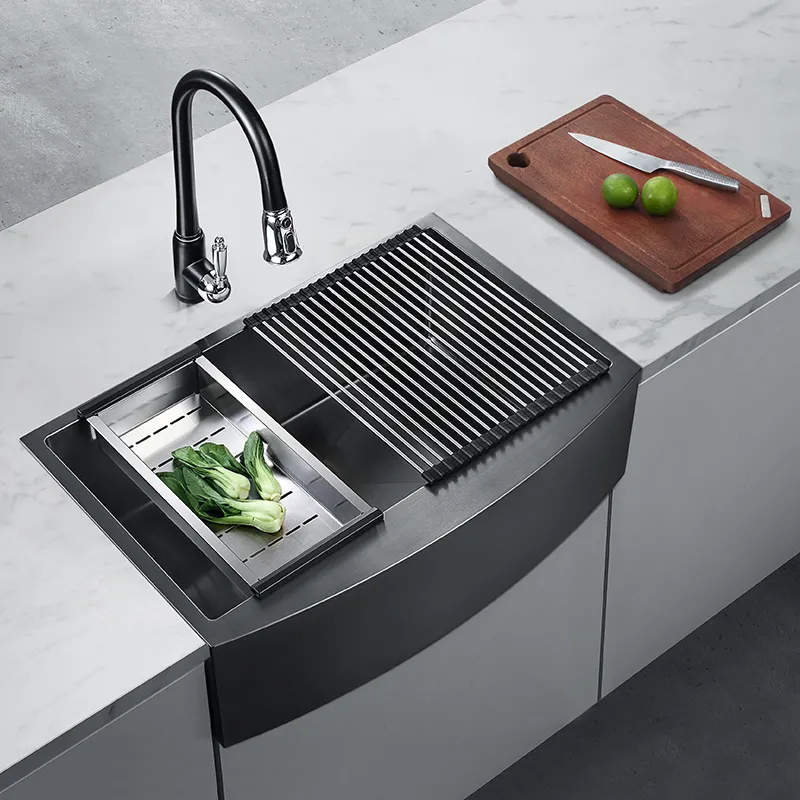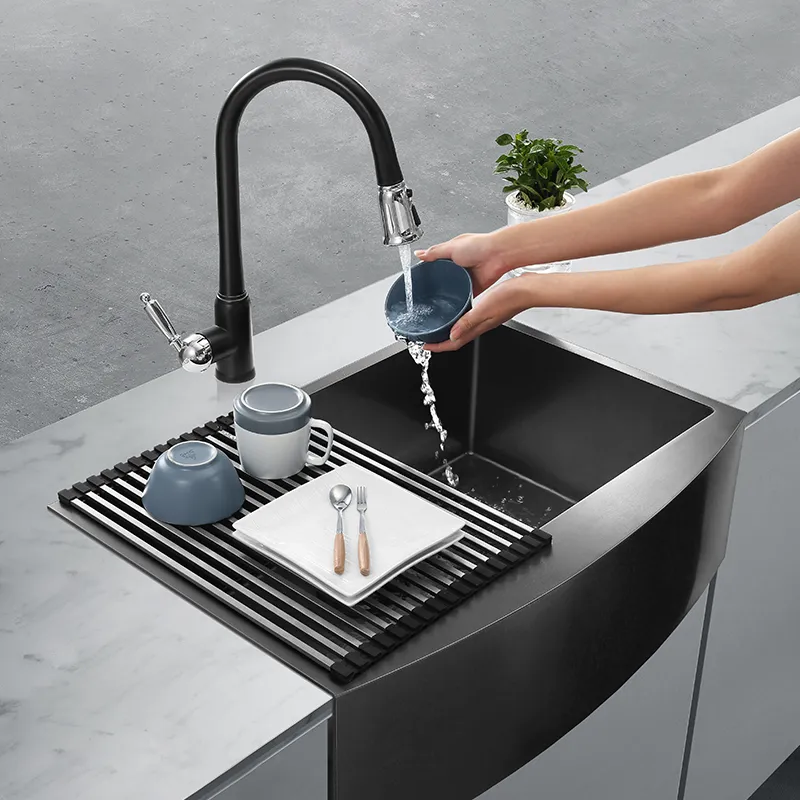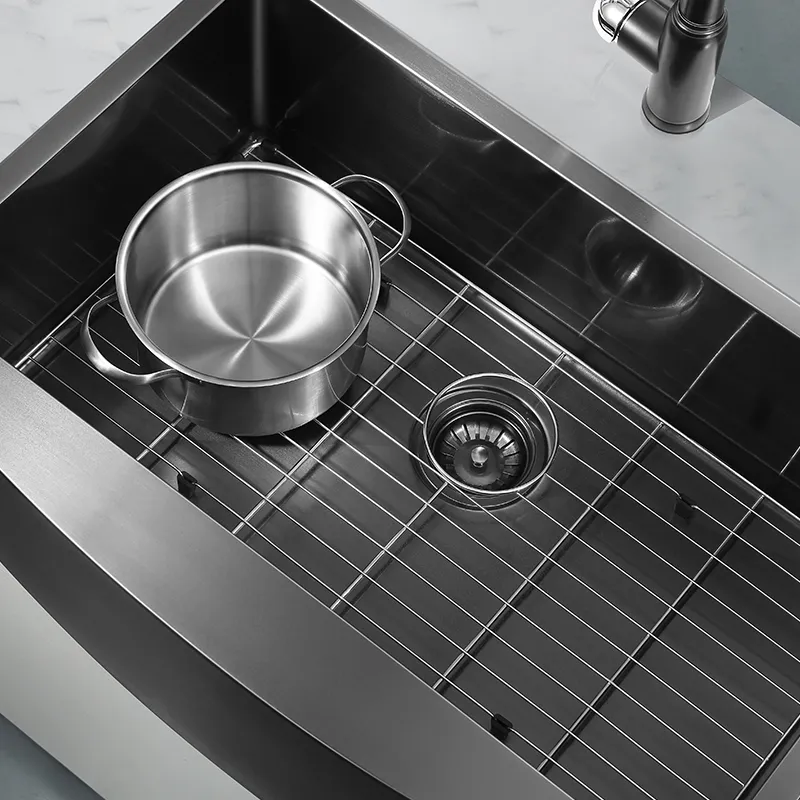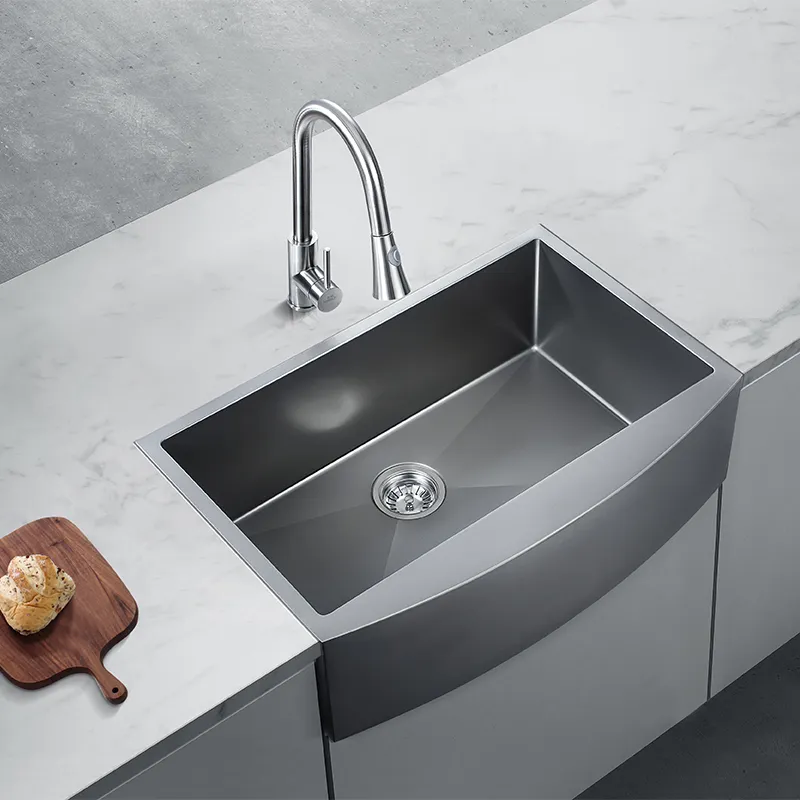In recent years, apron-front sinks have become increasingly popular in both home and professional kitchens due to their unique appearance and functional design. Compared to traditional undermount sinks, apron-front sinks not only offer a strikingly modern aesthetic but also offer superior ease of use, cleaning efficiency, and space utilization.
This article will provide a comprehensive and professional analysis of the question, "What are the benefits of an apron-front sink?" We will delve into its definition, features, materials, installation methods, advantages and disadvantages, and a purchasing guide to provide a systematic reference.

What is an apron-front sink?
An apron-front sink is a type of sink design characterized by a front that extends beyond the cabinetry, creating an apron-like appearance. It typically consists of a single sink, an apron front panel, and additional accessories. Apron-front sinks are designed with a focus on visual aesthetics, ease of use, and space utilization. Their core concept is to combine functionality and aesthetics to meet the diverse requirements of modern kitchens for efficiency, hygiene, and visual appeal.
1. Construction Features
Apron-style sinks consist of three main parts:
• Main bowl: The core of the sink, used to contain water and wash food and dishes. The main bowl is typically constructed of stainless steel, quartz, or a composite material, ensuring both durability and aesthetics.
• Apron front: This panel extends from the front edge of the sink. It serves not only as a visual feature but also as a splash barrier during use, protecting the cabinet from water damage.
• Accessories: These include drain baskets, cutting boards, and strainers. Some apron-style sinks offer a variety of functions, making them convenient for food preparation and dishwashing.
2. Design Concept
The apron-style sink emphasizes centralized functionality and user-friendly operation. By extending the front edge of the sink to form an apron, users can naturally move closer to the sink when washing food or dishes, while minimizing the risk of water splashing onto the floor or cabinets. This design is particularly suitable for home kitchens, open kitchens, and professional workspaces, balancing aesthetics with practicality.

What is the purpose of an apron-style sink?
1. Splash-Proof Function
The extended front panel of an apron-style sink effectively prevents water from splashing out of the sink, protecting cabinets and floors from water stains. Water splashing around the sink is a common problem during daily cooking and cleaning. The extended front design of an apron-style sink significantly improves kitchen cleanliness and tidiness.
2. User Comfort
Apron-style sink allows users to sit close to the sink while operating, reducing the need to bend or reach. The front-mounted design of an apron-style sink provides a more natural, ergonomic experience, especially when washing large pots and pans or preparing food, reducing back strain and improving cooking efficiency.
3. Multifunctional Integration
Modern apron-style sinks often come with removable accessories such as a drain basket, cutting board, and strainer, allowing the sink to be used not only for washing food but also for chopping, draining, and sorting. This integrated design keeps the kitchen countertop tidy and the work process more efficient.
4. Optimizing Space Utilization
Apron-style sinks can achieve three-dimensional space utilization through a well-designed deep basin and additional functional accessories. For example, washed vegetables can be drained directly into the drain basket and then cut with a cutting board, without taking up additional countertop space. For small kitchens, apron-style sinks can improve both efficiency and space utilization.
5. Aesthetics and Decorative Features
The extended front panel design of apron-style sinks creates a strong modern and decorative effect, making them particularly suitable for open kitchens and modern minimalist styles. The choice of material and color can coordinate with the countertop and cabinets, enhancing the overall aesthetics of the kitchen.

Material Characteristics and Impact of Apron-style Sinks
The material of an apron-style sink directly determines its lifespan, durability, and ease of cleaning. Common materials include:
1. Stainless Steel
Stainless steel is corrosion-resistant, heat-resistant, and stain-resistant, making it suitable for frequent daily use. Apron-style sinks made of stainless steel are not only durable but also easy to clean, maintaining a long-lasting, bright finish.
2. Quartz or Composite Material
Quartz apron-front sinks are beautiful, durable, and feature a fine, textured surface, making them suitable for modern kitchens. However, they are heavy and require support during installation. Composite sinks also emphasize aesthetics and ease of cleaning, but are slightly less durable than stainless steel and natural stone.
3. The Impact of Material Selection
The material not only affects durability and aesthetics but also determines the sink's antibacterial and stain-resistant properties, as well as user comfort. Material is a primary consideration when choosing an apron-front sink.
What are the installation options for apron-front sinks?
1. Undercounter Installation
Apron-front sinks can be installed under the countertop, with the sink body fixed beneath the countertop, leaving the apron front exposed. This design offers a clean, visually appealing look, complements the overall style of modern kitchens, and makes cleaning countertop debris and water stains easier.
2. Above-Counter Installation
An above-counter installation places the sink body directly on the countertop, with the apron front flush with the cabinet panels, creating a cohesive look and making it easy to operate. Above-counter apron-front sinks are ideal for kitchen remodels or when countertop space is limited.
3. Integrated Installation
Some high-end apron-front sinks feature a one-piece design, with the sink and apron front integrally cast. This provides a secure installation, superior waterproofing, easy maintenance, and a beautiful, elegant appearance.
What are the advantages of an apron-front sink?
1. Improved Efficiency
Through its multi-functional integration and ergonomic design, apron-front sinks centralize operations like washing, cutting, and draining, reducing time and improving kitchen efficiency.
2. Improved Hygiene
The apron front design effectively prevents water splashing out of the sink, minimizing water accumulation on cabinets and floors, reducing the potential for bacterial growth, and ensuring a clean and tidy kitchen.
3. Aesthetics
The apron-front sink's modern, minimalist design complements any kitchen style. A variety of materials and colors are available, enhancing overall aesthetics.
4. Efficient Space Utilization
Integrated functional accessories and a deep sink design maximize countertop space utilization, making them ideal for smaller kitchens and keeping the worktop tidy.
5. High Durability
Apron-front sinks made of high-quality stainless steel or quartz are corrosion-resistant and wear-resistant, meeting the demands of long-term use in both home and commercial kitchens.

What are the disadvantages of apron-front sinks?
1. Higher Cost: The integrated design and high-quality materials make apron-front sinks more expensive than traditional built-in sinks.
2. Complex Installation: Heavy or one-piece sinks require specialized support and fixings, increasing installation complexity.
3. Cleaning Requirements: While the front panel and deep sink design are aesthetically pleasing, cleaning corners requires care to prevent water and dirt from accumulating.
4. Space Requirements: Apron-front sinks occupy cabinet fronts, so small kitchens require advance measurements.
Apron-front sinks: Who is it suitable for?
Apron-front sinks are suitable for the following users:
• Families seeking a beautiful and comfortable kitchen
• Users with frequent kitchen operations who require integrated multi-functionality
• Families with small kitchens who want to optimize countertop space
• Users who prioritize hygiene and splash protection
Apron-front sink: Purchasing Tips
1. Identify functional requirements: Choose a deep sink, accessories, and splash protection based on your kitchen usage frequency and operating habits.
2. Material selection: Stainless steel or quartz are preferred, balancing durability and easy cleaning.
3. Installation method: Choose between undercounter, abovecounter, or integrated designs based on the kitchen countertop and cabinetry structure.
4. Accurate Dimensions: Ensure the apron-front sink's dimensions match the countertop and cabinetry, ensuring a secure installation.
5. Brand and after-sales service: Choose a reputable brand with comprehensive after-sales service to ensure long-term user experience.
"What's the point of an apron-front sink?"
The apron-front sink's unique design addresses the issues of traditional sinks—splashing, inconvenient operation, and insufficient space utilization—making it an indispensable fixture in the modern kitchen. Its splash-proof design, deep sink capacity, and versatile accessories centralize and streamline kitchen operations, optimizing space utilization. Despite higher price and installation requirements, apron-front sinks are an ideal choice for modern home and professional kitchens in terms of user experience, durability, and overall aesthetics.
How does Higold manage product innovation year after year?
Higold invests heavily in R&D, maintaining an independent innovation team and advanced testing facilities. The company studies consumer lifestyle changes, design trends, and material science to create more intelligent and stylish sinks. This dedication results in over 20 new products annually, keeping wholesale buyers supplied with fresh and competitive designs. Innovation is not only about aesthetics—it also improves usability and adds value for end customers.


